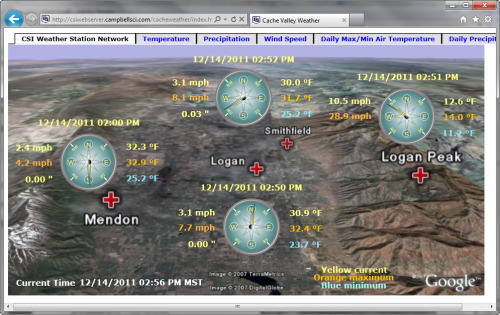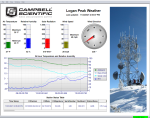






Überblick
Aktuelle Version: 1.6
CSI Webserver ermöglicht es, RTMC Projekte über jeden Webbrowser, der HTML5 unterstützt zu publizieren.
Mit dem WebServer Administrator kann man den Webserver konfigurieren, den Status überprüfen und zu den Seiten gehen, die darauf laufen. Mann kann auch RTMC Projekte auf einer PC Webseite oder einem HTTP-fähigen Datenlogger publizieren. CSI Webserver ist bei RTMC-pro inklusive, er kann aber auch einzeln zur Anwendung mit RTMC (inklusive mit LoggerNet, LoggerNet Admin und RTDAQ) erworben werden.
Lesen Sie mehrBilder

Technische Beschreibung
The CSI Web Server allows you to view your RTMC projects using a web browser. You can also change input locations and public variable values, toggle ports/flags, and browse through historical report data from a web browser.
Included with the CSI Web Server are the CSI Web Server Administrator and the Web Publisher. The CSI Web Server Administrator allows you to configure the web server, check the status of the web server, and easily browse to sites running on the web server. The Web Publisher allows you to publish your RTMC or RTMC Pro project to either a PC website running the CSI Web Server or to an HTTP-enabled datalogger such as a CR6 or CR1000 with an NL120 attached. (Publishing to a datalogger requires an RTMC Pro project.) In addition, the Web Publisher has display settings that allow you to show other tabs for data browsing and network status.
Security for the CSI Web Server is provided through password file(s) that control the rights of different users to view data, change data values, and publish websites.
The CSI Web Server supports HTTPS encrypted communication. To use HTTPS, a Private Key file and Certificate File must be obtained from a third-party Certificate Authority.
Kompatibel mit
Please note: The following shows notable compatibility information. It is not a comprehensive list of all compatible products.
Datenlogger
| Product | Compatible | Note |
|---|---|---|
| CR1000 (retired) | ||
| CR1000X (retired) | ||
| CR200X (retired) | ||
| CR216X (retired) | ||
| CR300 (retired) | ||
| CR3000 | ||
| CR310 | ||
| CR350 | ||
| CR5000 (retired) | ||
| CR6 | ||
| CR800 (retired) | ||
| CR850 (retired) | ||
| CR9000X (retired) |
Additional Compatibility Information
Software
CSI Web Server is optimized for using projects created with the RTMC 4.x development tools (standard RTMC Development or RTMC Pro). Although CSI Web Server can use projects from version 2.x or 3.x development tools, the web display may look different than what’s expected. For best performance, RTMC version 4.x development tools should be used to develop projects for CSI Web Server.
Computer
CSI Web Server runs on Windows 10 and 11. CSI Web Server runs on both 32-bit and 64-bit versions of these operating systems.
Web Browser
CSI Web Server requires HTML 5. The following target browsers are supported at the indicated version or later:
- Chrome 10
- Firefox 4
- Internet Explorer 9
- Microsoft Edge 117
- Opera 11
- Safari 5
Spezifikationen
| Current Version | 1.6 |
| Operating System | Windows 11 or 10 (Both 32- and 64-bit operating systems are supported.) |
Dokumente
Broschüren Produkte
Handbücher
Downloads
CSI Web Server Patch v.1.7 (37.8 MB) 22-05-2024
Campbell Scientific has an option to buy the CSI Web Server as a stand-alone product.
This patch will upgrade the stand-alone installation of the CSI Web Server version 1.0 and newer to 1.7. A qualifying version of the CSI Web Server must be installed on the computer.
Note: This will not upgrade the CSI Web Server installed with RTMC Pro.
FAQs für
Number of FAQs related to CSIWEBS: 2
-
A network camera can be connected directly to a CR1000 or CR3000 via an NL115 or NL120 and a crossover cable. The datalogger can retrieve and store images from the network camera. Then the images can be viewed or retrieved from the datalogger in a variety of ways. These include using LoggerNet, the datalogger’s web server, the datalogger’s FTP client/server, or the datalogger’s email client.
-
The blog article "How to Navigate the World of Software Upgrades, Patches, and Trials" explains the difference between patches (free of charge) and upgrades (for a fee). This example quickly shows the difference between an upgrade and a patch:
Upgrade Patch Major version change, such as 1.3 to 2.0
Minor version change, such as 1.3 to 1.4
Typically requires purchase for a fee
Free of charge
Anwendungsbeispiele
Die Wetterstation des Instituts für Geoökologie, Klimatologie und Umweltmeteorologie, realisiert mit einem CR1000 und über......lesen Sie mehr



